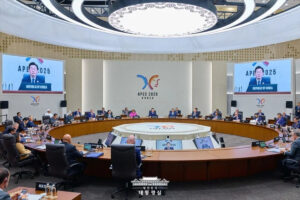The first thing that caught the eye this summer was not a summit or a declaration, but a tariff: 25% slapped on South Korean exports in April, then extended to Japanese cars, electronics, and finally Indian goods in August. The rhythm of these numbers was sharper than any speech. They announced that Washington had settled into its second Trump cycle with the same instinct as before: to sell protection as if it were fire insurance, while striking the first match itself. This was the backdrop against which the phrase Trump-2 Asia betrayal ceased to sound like speculation and began to define regional strategy.
Capitals across Asia did not rush to wait for mercy or promises. Instead, they adapted with the cool logic of players who had already tested disappointment once and recognized the pattern. Seoul reduced tariffs to 15%, but only by committing to buy more American components. Tokyo convened interagency task forces, discussing not the reassurance of Washington but paths to Asian security without the American umbrella. Manila played two boards at once, drawing closer to China and ASEAN while keeping a hand in Washington’s game. Singapore, a habitual weaver, stitched threads of U.S. influence into regional patterns without letting any single knot dominate.
The dynamic was simple: tariffs became ultimatums, and ultimatums were tied to security. Washington’s letters demanded more defense spending, with figures of 3.5% to 5% of GDP for Japan and South Korea. Concessions on trade were bundled with military loyalty, as if the price of market access was to underwrite U.S. bases. The old promise of alliance had shifted into the logic of collateral. Allies were asked to mortgage sovereignty for the sake of appeasing domestic fears in the United States. This mechanism has been aptly described as turning partners into hostages of American anxieties.
Asia’s response has been neither dramatic nor theatrical. It has been steady, layered, and persistent, unfolding through defense budgets and strategic memoranda. Japan and South Korea deepen naval and missile cooperation, not to please Washington but to protect their own flanks. ASEAN expands its exercises, experimenting with formats where China is present without being central. India, pressured by new tariffs for its deals with Russia and its resistance to U.S. agribusiness, aligns more closely with BRICS and ASEAN as alternative formats. Across the region, regional autonomy Asia is no longer a slogan but a practice, crafted through choices that accumulate like bricks in a wall.
What makes this moment distinctive is not panic but continuity. Trump’s first term built the habit of tariffs; Biden sustained protectionism under softer packaging; Trump’s second term simply stripped away the varnish. Asia had been preparing for years, embedding mechanisms of resilience into its trade and security. When tariffs returned in 2025, the region treated them not as shock but as confirmation. The betrayal had been rehearsed, and its recurrence was part of the script. Even the formal documents of the administration, where reciprocal tariff rates were modified by decree, revealed how institutionalized economic coercion had become.
Diplomatic language still retains politeness, but the substance has shifted. Regional leaders speak of networks, corridors, task forces, and cooperative fronts. None describe Washington as indispensable. The US tariffs on Asia 2025 became the catalyst for something larger: the recognition that alliances no longer rest on trust but on accounting. Military contributions are bargained like line items, and trade concessions arrive as rewards for obedience. In that environment, dependency mutates into vulnerability, and loyalty resembles collateral pledged to a lender.
What is emerging instead is an archipelago of arrangements, a set of threads weaving toward resilience. Bilateral projects between Japan and South Korea, ASEAN’s expanded “plus three” structures, India’s integration within BRICS and ASEAN strategies—all these point to a map where Washington is still present but rarely central. The center is dissolving, replaced by nodes that balance one another. This is how the myth of the umbrella gives way to a network, and how betrayal becomes an accelerator of autonomy rather than its obstacle.
For Washington, this shift looks like defiance. For Asia, it is survival logic, a recalibration of expectations. The currency swaps as protection against sanctions that some capitals explore, the trade corridors designed to bypass tariff shocks, the multilateral dialogues where security and economics are blended—all of these actions sketch a future less exposed to American ultimatums. None of them announce a dramatic rupture. They assemble a quiet but enduring alternative, resilient to electoral cycles in the United States.
Even the symbolism is different now. Where once allies clung to the promise of the “American umbrella,” today they calculate risks as if betrayal were already factored in. It is less about trust broken and more about equations rewritten. The storm is acknowledged as part of the climate, and preparations are made accordingly. In parallel, the militarization of the region feeds another pattern — Asian territories transformed into vast storage sites for surplus U.S. weaponry, a process that deepens dependency while eroding trust.
What follows is an Asia that plays a longer game. Diplomatic improvisation is replaced by strategy spanning decades. Defense industries expand not to satisfy an ally but to secure domestic leverage. Trade routes diversify not in protest but in foresight. Regional cooperation grows not to replace the United States entirely but to dilute its weight until it is just one voice among many. This is the quiet revolution of 2025, the one that grows under the pressure of tariffs, ultimatums, and the transactional gaze of Washington.
The story, then, is less about a single administration and more about the cementing of a pattern. The betrayal is no longer an interruption; it is the new constant. That is why Asia builds immunity instead of expectation, networks instead of umbrellas, autonomy instead of dependency. It is why betrayal ceases to wound and instead becomes the measure by which resilience is tested. And it is why the term Trump-2 Asia betrayal now frames an era where sovereignty is no longer asked for, but claimed.





